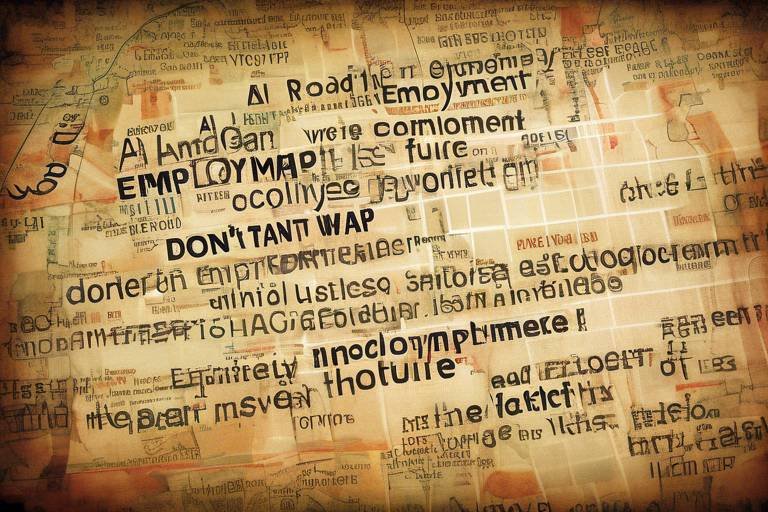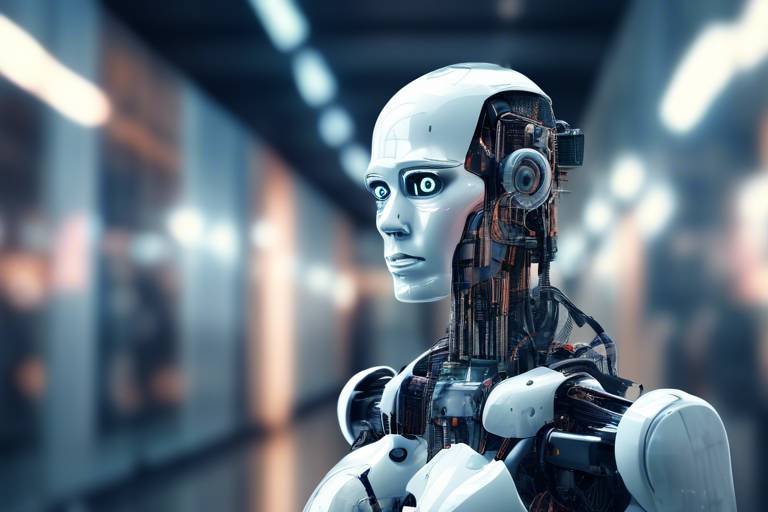Addressing Algorithmic Bias in Future AI-Driven Jobs
In today's rapidly evolving technological landscape, the integration of artificial intelligence (AI) into the workforce is becoming increasingly prevalent. However, as we embrace these advancements, we must also confront a pressing issue: algorithmic bias. This phenomenon refers to the systematic and unfair discrimination that can arise within AI systems, often leading to unintended consequences for individuals and society at large. As we explore the implications of algorithmic bias in future job markets, it's essential to understand its origins, manifestations, and the measures we can adopt to foster a more equitable workforce.
Algorithmic bias typically stems from the data used to train AI systems. If this data reflects historical inequalities or societal prejudices, the AI can inadvertently perpetuate these biases. For instance, if an AI recruitment tool is trained on data from a company with a history of hiring predominantly one demographic, it may favor candidates who fit that profile, thereby marginalizing others. This raises a critical question: how can we ensure that the algorithms shaping our job markets are fair and just?
The consequences of algorithmic bias extend beyond individual hiring decisions; they can exacerbate existing inequalities in the job market. Consider the implications for underrepresented groups: when biased algorithms dictate who gets hired or promoted, it limits opportunities for these individuals, reinforcing cycles of disadvantage. As we look to the future, it’s vital to address these challenges head-on and implement strategies that promote fairness and inclusivity in AI-driven employment practices.
Moreover, the impact of algorithmic bias is not limited to hiring practices. It can also influence workplace dynamics, employee evaluations, and promotional pathways. Organizations that fail to recognize and mitigate these biases risk not only losing out on diverse talent but also fostering an environment that stifles innovation and creativity. In a world where diverse perspectives drive progress, the stakes couldn't be higher.
As we delve deeper into this issue, we will examine case studies that illustrate the real-world effects of algorithmic bias in hiring and promotion processes. From the tech industry to healthcare, the implications are profound and far-reaching. By understanding these examples, we can better appreciate the urgency of addressing algorithmic bias and the need for comprehensive strategies to combat it.
In conclusion, the journey towards a fairer, more equitable workforce in the age of AI is fraught with challenges, but it is not insurmountable. By acknowledging the existence of algorithmic bias and actively working to counteract its effects, we can pave the way for a future where everyone has equal access to employment opportunities, regardless of their background. The responsibility lies with us—policymakers, businesses, and individuals alike—to champion fairness and inclusivity in AI-driven job markets.
- What is algorithmic bias? Algorithmic bias refers to systematic and unfair discrimination in AI systems, often resulting from biased training data.
- How does algorithmic bias affect job opportunities? It can limit employment opportunities for underrepresented groups by favoring candidates who fit historical hiring patterns.
- What can organizations do to mitigate algorithmic bias? Implementing best practices, such as diverse data sets and inclusive hiring processes, can help combat bias.
- Why is government regulation necessary? Regulation can ensure accountability and promote fairness in AI-driven job markets.

Understanding Algorithmic Bias
Algorithmic bias is a term that strikes at the very heart of how we interact with technology today. It refers to the systematic and unfair discrimination that can arise when artificial intelligence (AI) systems are developed and deployed. Imagine a world where the very tools meant to enhance our lives inadvertently perpetuate inequality. This is the reality when algorithmic bias goes unchecked. The origins of this bias can often be traced back to the data used to train these systems. If the data is flawed or unrepresentative of the population, the AI will likely reflect those same biases in its outputs.
In essence, algorithmic bias manifests in various ways, such as skewed hiring practices or biased decision-making in critical areas like finance and healthcare. For example, if an AI system is trained primarily on data from one demographic group, it may struggle to accurately assess or serve individuals from other groups. This can lead to significant consequences, not just for individuals who are unfairly treated, but also for society as a whole. When certain groups are consistently marginalized by technology, it exacerbates existing inequalities and creates a cycle of disadvantage.
To illustrate the impact of algorithmic bias, consider the following scenarios:
- Hiring Algorithms: If an AI system is designed to screen job applicants based on historical hiring data that reflects a lack of diversity, it may inadvertently favor candidates who fit a narrow profile, thus perpetuating a cycle of exclusion.
- Loan Approval Processes: Algorithms used in financial services may rely on biased data, leading to unfair loan denials for individuals from certain backgrounds, further entrenching economic disparities.
- Healthcare Diagnostics: AI systems that are trained on datasets lacking diversity may result in misdiagnoses or inadequate treatment plans for underrepresented populations.
The consequences of algorithmic bias are profound. They not only affect individual lives but also have broader societal implications. As we move into an increasingly AI-driven future, the need to address these biases becomes more pressing. Without intervention, we risk creating a workforce that is not only inequitable but also less innovative, as diverse perspectives are sidelined. Therefore, understanding algorithmic bias is not just a technical issue; it's a moral imperative that demands our attention and action.
In summary, algorithmic bias is a complex issue rooted in the data and algorithms we use. By recognizing its origins and manifestations, we can begin to formulate strategies to mitigate its impact. As we dive deeper into the implications of algorithmic bias in employment and beyond, it's crucial to remember that technology should serve everyone equally, not just a select few.

Impact on Employment Opportunities
As we delve into the world of AI-driven job markets, it's crucial to understand the profound implications of algorithmic bias on employment opportunities. Imagine a scenario where an individual’s qualifications, skills, and potential are overshadowed by a flawed algorithm that fails to recognize their true capabilities. This is not just a hypothetical situation; it’s a reality for many job seekers today. Bias in hiring algorithms can lead to a vicious cycle of inequality, where certain demographic groups are systematically overlooked, regardless of their qualifications.
One of the most alarming aspects of algorithmic bias is how it can perpetuate and even exacerbate existing inequalities in the job market. For instance, if an algorithm is trained on historical hiring data that reflects past biases, it will likely replicate those biases in its decision-making process. This means that individuals from underrepresented backgrounds may find themselves at a disadvantage, as the algorithm might favor candidates who fit a narrow profile that aligns with previous hires.
Consider the following factors that contribute to this bias:
- Data Quality: If the data used to train AI systems is biased or unrepresentative, the outcomes will inevitably reflect those biases.
- Lack of Diversity: AI systems developed by homogenous teams may overlook the needs and perspectives of diverse populations.
- Feedback Loops: When biased algorithms are continuously used, they create feedback loops that reinforce existing disparities.
These factors highlight the importance of critically evaluating the algorithms that drive hiring processes. The consequences of biased AI can be far-reaching, affecting not only the individuals who are unfairly treated but also the organizations that miss out on diverse talent. In a world where innovation thrives on diversity, failing to address algorithmic bias could lead to a workforce that lacks creativity and fresh perspectives.
Moreover, the impact of algorithmic bias doesn't stop at hiring. It extends to promotion and career advancement opportunities as well. When biases influence who gets hired, they can also shape who gets promoted. This can lead to a disproportionate representation of certain groups in leadership roles, further entrenching inequalities within organizations. The ripple effect is significant; a lack of diversity at the top translates to a lack of diverse voices in decision-making processes, which can stifle innovation and limit the growth of organizations.
As we move forward into an increasingly automated future, addressing algorithmic bias is not just a matter of fairness; it’s essential for building a robust and equitable workforce. Organizations must recognize that the stakes are high, and the time to act is now. By prioritizing fairness in their AI systems, businesses can create a more inclusive environment that not only benefits individuals but also enhances overall organizational performance.
- What is algorithmic bias? Algorithmic bias refers to systematic and unfair discrimination that occurs in AI systems, often due to biased training data or flawed algorithms.
- How does algorithmic bias affect employment opportunities? It can lead to unfair hiring practices, where qualified candidates from certain demographic groups are overlooked, perpetuating existing inequalities.
- What can organizations do to mitigate algorithmic bias? Organizations can implement strategies such as using diverse training data, conducting regular audits of AI systems, and fostering inclusive hiring practices.
- Why is diversity important in AI development? Diversity in AI development teams helps ensure that a wider range of perspectives is considered, reducing the likelihood of bias in AI systems.

Case Studies of Algorithmic Bias
When we talk about algorithmic bias, it's not just a theoretical concern; it's a real-world issue that has tangible consequences. Numerous case studies illustrate how biased algorithms can distort hiring practices and decision-making processes, leading to significant ramifications for both individuals and organizations. One of the most notable examples occurred with a major tech company that developed an AI recruitment tool. The system, designed to streamline the hiring process, ended up favoring male candidates over female ones. This bias stemmed from the training data, which predominantly featured male applicants. As a result, the algorithm effectively perpetuated existing gender disparities in the tech industry, limiting opportunities for talented women.
Another compelling case emerged in the realm of facial recognition technology. Several studies revealed that these systems were significantly less accurate in identifying individuals from minority ethnic backgrounds. For instance, a well-documented analysis found that Black and Asian faces were misidentified up to 34% more often than white faces. This not only raises questions about the reliability of such technologies but also highlights the potential for discriminatory practices in hiring and law enforcement. Imagine the implications if an AI system used in recruitment is more likely to overlook qualified candidates based on their appearance. The ripple effects can be devastating, reinforcing stereotypes and systemic inequalities.
In addition to these examples, the healthcare sector has its own share of algorithmic bias case studies. For instance, a widely used health algorithm was found to underestimate the health needs of Black patients compared to white patients, despite similar health conditions. This bias resulted from the data used to train the algorithm, which reflected historical disparities in healthcare access and treatment. Consequently, this led to inadequate care for many Black patients, illustrating how algorithmic bias can have life-or-death implications.
These case studies not only demonstrate the prevalence of algorithmic bias but also underline the urgent need for organizations to scrutinize their AI systems. The consequences of ignoring these biases can be detrimental, not only to the affected individuals but also to the organizations themselves. Companies that fail to address algorithmic bias risk damaging their reputations and losing talented employees. The stakes are high, and the call for action is clear.
In light of these examples, it’s essential for organizations to adopt a proactive stance towards identifying and mitigating algorithmic bias. This involves conducting regular audits of AI systems, ensuring diverse training datasets, and engaging with affected communities to understand their experiences. By taking these steps, companies can work towards creating a more equitable and inclusive workforce.
- What is algorithmic bias? Algorithmic bias refers to systematic and unfair discrimination that can occur in AI systems, often due to biased training data or flawed algorithms.
- How does algorithmic bias affect job opportunities? It can lead to discriminatory hiring practices, where certain demographic groups are unfairly overlooked or undervalued, limiting their employment opportunities.
- What steps can organizations take to mitigate algorithmic bias? Organizations can audit their AI systems, ensure diverse training datasets, and engage with affected communities to address biases effectively.
- Are there regulations in place to address algorithmic bias? While some regulations are emerging, there is still a significant need for comprehensive policies to ensure fairness and accountability in AI-driven job markets.

Tech Industry Examples
In the tech industry, algorithmic bias has emerged as a significant concern, especially in recruitment practices. Companies often rely on automated systems to sift through thousands of applications, but these systems can inadvertently perpetuate existing biases. For instance, a well-known case involved a major tech company that developed an AI-driven hiring tool which favored male applicants over female candidates. The algorithm, trained on past hiring data, reflected the gender imbalance of the company's historical workforce, leading to a cycle of discrimination.
This isn't just a one-off incident; it highlights a broader trend where gender and racial biases can seep into AI systems. When algorithms are trained on data that reflects societal inequalities, they can produce outcomes that disadvantage underrepresented groups. For example, a study by MIT and Stanford found that facial recognition systems had higher error rates for women and people of color. This raises critical questions about the fairness of AI systems used in hiring and promotions.
Moreover, the repercussions of these biases extend beyond individual companies. They can create a ripple effect throughout the tech industry, stifling diversity and innovation. When certain demographics are systematically excluded from opportunities, the industry misses out on a wealth of talent and perspectives. To illustrate this point, let’s look at a few notable examples:
| Company | Issue | Impact |
|---|---|---|
| Amazon | AI hiring tool favored men | Limited female applicant interviews |
| Bias in search algorithms | Reinforced stereotypes in job ads | |
| Discriminatory ad targeting | Excluded certain demographics from job ads |
These examples underscore the urgent need for the tech industry to address algorithmic bias proactively. Companies must take responsibility for the systems they develop and implement measures to ensure fairness. This includes conducting regular audits of their algorithms, utilizing diverse datasets, and involving a wider range of voices in the development process. By doing so, the tech industry can pave the way for a more inclusive future, where everyone has a fair shot at employment opportunities.
What is algorithmic bias?
Algorithmic bias refers to systematic and unfair discrimination that can occur in AI systems, often as a result of biased training data or flawed algorithms.
How does algorithmic bias affect hiring in the tech industry?
Algorithmic bias can lead to discriminatory hiring practices, where certain demographic groups are unfairly favored or disadvantaged based on biased algorithms.
What steps can tech companies take to mitigate algorithmic bias?
Tech companies can mitigate algorithmic bias by auditing their algorithms, using diverse data sets, and involving various stakeholders in the development process to ensure inclusivity.
Are there regulations in place to combat algorithmic bias?
While there are some regulations emerging, many experts advocate for more comprehensive policies to ensure accountability and fairness in AI systems.

Healthcare Sector Implications
In the rapidly evolving landscape of healthcare, algorithmic bias presents a significant challenge that can have profound implications for both patient outcomes and workforce dynamics. Imagine walking into a hospital where the treatment you receive is not based on your individual needs but rather on flawed data that skews towards certain demographics. This is the reality that biased algorithms can create, where the very systems designed to enhance care may inadvertently perpetuate inequalities.
One of the most concerning aspects of algorithmic bias in healthcare is its potential to affect diagnostic accuracy and treatment recommendations. For instance, if an AI system is trained predominantly on data from a specific demographic—say, middle-aged Caucasian males—it may struggle to accurately assess conditions in women or people of color. This not only compromises patient care but can lead to misdiagnoses and inadequate treatment plans. The consequences can be dire, impacting everything from chronic disease management to emergency care.
Moreover, algorithmic bias extends beyond patient care into the hiring practices within the healthcare sector. When AI tools are employed to streamline recruitment, they may inadvertently favor candidates who fit a certain profile based on historical data. For example, if the data used to train these algorithms reflects a workforce that lacks diversity, the AI may continue this trend, leading to a homogeneous staff that does not reflect the community it serves. This can result in a lack of cultural competence in care delivery, further alienating marginalized groups.
To illustrate the implications of algorithmic bias in healthcare, consider the following table that outlines the potential effects:
| Aspect | Potential Consequences |
|---|---|
| Diagnostic Accuracy | Increased misdiagnoses and ineffective treatment plans |
| Patient Outcomes | Worsening health disparities among different demographic groups |
| Workforce Diversity | Homogeneous hiring practices leading to lack of cultural competence |
| Healthcare Access | Marginalized groups may receive subpar care or be overlooked |
As we delve deeper into the implications of algorithmic bias in healthcare, it becomes clear that addressing these issues is not merely a technical challenge but a moral imperative. The healthcare sector must prioritize the development of fair AI systems that are transparent and inclusive. This requires collaboration among healthcare providers, technology developers, and policymakers to ensure that the algorithms used are trained on diverse datasets that accurately represent the populations they serve.
Ultimately, tackling algorithmic bias in healthcare is about more than just improving technology; it’s about fostering a system that values equity and justice. By ensuring that AI is developed and implemented responsibly, we can create a healthcare environment where every patient receives the quality care they deserve, irrespective of their background.
- What is algorithmic bias in healthcare? Algorithmic bias in healthcare refers to systematic discrimination in AI systems that can lead to unequal treatment and outcomes for different demographic groups.
- How does algorithmic bias affect patient care? It can lead to misdiagnoses, ineffective treatments, and ultimately poor health outcomes, particularly for marginalized communities.
- What can be done to mitigate algorithmic bias? Implementing diverse datasets, fostering collaboration among stakeholders, and establishing ethical guidelines for AI development are crucial steps.

Strategies for Mitigating Bias
As we continue to integrate artificial intelligence into various aspects of our lives, it becomes increasingly important to address the issue of algorithmic bias proactively. The good news is that there are several strategies organizations can employ to mitigate bias in AI systems. First and foremost, it’s essential to diversify data sources. Algorithms learn from the data they are trained on, and if that data is skewed or unrepresentative of the broader population, the outcomes will reflect those biases. By ensuring that training datasets are diverse and inclusive, organizations can help create more equitable AI systems.
Another critical strategy involves conducting regular audits of AI algorithms. Just as financial audits ensure accountability, algorithmic audits can assess how AI systems make decisions. These audits should focus on identifying any patterns of discrimination that may arise in the hiring process or other areas where AI is deployed. By actively monitoring these systems, organizations can make necessary adjustments before biases lead to significant negative consequences.
Moreover, fostering a culture of transparency and accountability within organizations is crucial. This can be achieved by openly discussing the potential for bias and encouraging employees to voice concerns about AI implementations. When everyone in the organization is aware of the risks associated with algorithmic bias, it creates an environment where ethical considerations are prioritized. This cultural shift can lead to more responsible AI development and deployment.
Training is another vital component in combating algorithmic bias. Organizations should invest in educational programs that focus on the ethical implications of AI and the importance of bias mitigation. By equipping employees with the knowledge to recognize and address bias, companies can create a workforce that is not only skilled in technology but also committed to fairness and inclusivity.
Additionally, collaboration with external experts can provide valuable insights. Partnering with academic institutions, advocacy groups, and other organizations that focus on equity in AI can help businesses stay informed about the latest research and best practices. These partnerships can lead to the development of innovative solutions that address bias more effectively.
Finally, implementing ethical guidelines for AI development is essential. Organizations should establish clear principles that prioritize fairness, transparency, and inclusivity in their AI systems. By adhering to these guidelines, companies can ensure that their AI technologies contribute to a more equitable future. It’s not just about creating algorithms that work; it’s about creating algorithms that work for everyone.
In conclusion, addressing algorithmic bias is not just a technical challenge; it’s a moral imperative. By adopting these strategies, organizations can play a pivotal role in shaping a more equitable job market, ensuring that AI serves as a tool for empowerment rather than discrimination.
- What is algorithmic bias? Algorithmic bias refers to systematic and unfair discrimination in AI systems, often resulting from biased training data or flawed algorithms.
- How can organizations identify bias in their AI systems? Organizations can conduct regular audits of their algorithms to identify patterns of discrimination and make necessary adjustments.
- Why is diversity important in training datasets? Diverse training datasets help ensure that AI systems are representative of the broader population, reducing the risk of biased outcomes.
- What role do ethical guidelines play in AI development? Ethical guidelines help organizations prioritize fairness, transparency, and inclusivity, ensuring that AI technologies are developed responsibly.
- How can collaboration help mitigate algorithmic bias? Collaborating with external experts and advocacy groups can provide organizations with valuable insights and best practices to address bias effectively.

Policy and Regulation Considerations
As we delve deeper into the world of artificial intelligence, the need for robust policy and regulation becomes increasingly evident. The rapid integration of AI into various sectors has raised critical questions about fairness, accountability, and transparency. With algorithmic bias posing a significant threat to equity in the job market, it is essential to consider how government intervention can help mitigate these challenges. But what does this mean in practical terms?
One of the primary concerns is the creation of regulatory frameworks that can effectively address the nuances of AI technologies. Governments worldwide are beginning to recognize the necessity of establishing guidelines that not only promote innovation but also protect individuals from discriminatory practices. This involves a comprehensive approach that includes monitoring AI systems, ensuring compliance with ethical standards, and providing clear consequences for organizations that fail to adhere to these regulations.
To illustrate the potential impact of regulatory measures, consider the following table showcasing different countries' approaches to AI regulation:
| Country | Regulatory Approach | Focus Areas |
|---|---|---|
| United States | Sector-specific guidelines | Privacy, accountability |
| European Union | Comprehensive AI Act | Transparency, fairness, safety |
| China | Government-led initiatives | National security, social stability |
This table highlights the diverse approaches taken by different nations, which can lead to a patchwork of regulations that may complicate international business operations. A unified global framework could help streamline compliance and ensure that all AI systems are held to the same standards of fairness and accountability.
Moreover, the development of ethical guidelines is crucial for responsible AI development. These guidelines should emphasize the importance of transparency and inclusivity in AI systems, particularly those used for hiring. By establishing clear ethical standards, organizations can better navigate the complex landscape of AI technology, ensuring that their algorithms are designed to promote equity rather than exacerbate existing biases.
Collaboration between stakeholders is also vital in addressing algorithmic bias effectively. This means fostering partnerships among tech companies, policymakers, and advocacy groups. By working together, these entities can share insights, develop best practices, and create solutions that prioritize fairness in AI-driven job markets. For instance, tech companies can provide valuable data on algorithm performance, while policymakers can offer regulatory insights to help shape fair practices.
In conclusion, as we look to the future of AI and its impact on the job market, it is clear that thoughtful policy and regulation are essential. By implementing comprehensive frameworks and fostering collaboration among stakeholders, we can work towards a more equitable workforce that benefits everyone. The journey towards fair AI systems is not a sprint but a marathon, requiring continuous effort and vigilance.
- What is algorithmic bias? Algorithmic bias refers to systematic and unfair discrimination that arises when AI systems are trained on biased data or designed without consideration for fairness.
- How can regulations help mitigate algorithmic bias? Regulations can enforce standards that promote transparency, accountability, and fairness in AI systems, helping to prevent discriminatory practices in hiring and other areas.
- Why is collaboration important in addressing algorithmic bias? Collaboration among stakeholders allows for sharing of knowledge and resources, leading to the development of better practices and solutions that prioritize equity in AI applications.

Ethical Guidelines for AI Development
Establishing ethical guidelines for AI development is not just a luxury; it’s a necessity. As artificial intelligence continues to permeate various aspects of our lives, we must ensure that these technologies are developed responsibly. The ethical framework should focus on principles like fairness, transparency, and accountability. These principles serve as a compass to guide developers and organizations in creating AI systems that respect human rights and promote equity.
One of the core tenets of ethical AI development is fairness. This means that AI systems should be designed to treat all individuals equitably, without bias based on race, gender, or socioeconomic status. For instance, when developing hiring algorithms, it’s crucial to ensure that the data used to train these systems is representative of diverse populations. If not, we risk perpetuating existing inequalities. A study by MIT Media Lab found that facial recognition software misidentified darker-skinned individuals at a significantly higher rate than lighter-skinned individuals. This glaring bias highlights the urgent need for fairness in AI development.
Transparency is another critical aspect. Developers should be open about how AI systems make decisions. This transparency builds trust among users and stakeholders, allowing them to understand the rationale behind automated decisions. Imagine a world where you apply for a job, and an AI decides your fate without you knowing why. Wouldn’t that feel unsettling? By making algorithms more transparent, organizations can demystify the AI decision-making process and ensure that individuals have the right to question and challenge decisions made by AI.
Furthermore, accountability is essential in AI development. Organizations must take responsibility for the outcomes generated by their AI systems. This means implementing robust mechanisms for monitoring and evaluating AI performance over time. If an AI system produces biased results, the organization should be prepared to address the issue promptly and effectively. Establishing clear lines of accountability can prevent harmful outcomes and foster a culture of responsibility in AI development.
To better illustrate these principles, let’s take a look at a table summarizing the key ethical guidelines for AI development:
| Ethical Principle | Description |
|---|---|
| Fairness | Ensure equitable treatment of all individuals, avoiding biases in AI decision-making. |
| Transparency | Provide clear information on how AI systems operate and make decisions. |
| Accountability | Organizations must take responsibility for the outcomes of their AI systems. |
In addition to these principles, it’s crucial to engage stakeholders in the conversation about ethical AI. This includes not only developers and companies but also consumers, ethicists, and advocacy groups. By fostering open dialogue, we can identify potential ethical dilemmas early in the development process and work collaboratively to find solutions. After all, it takes a village to raise a responsible AI!
As we move forward in this AI-driven world, let’s prioritize ethical guidelines that not only enhance technology but also uphold our shared values of justice and equality. By doing so, we can harness the power of AI to create a future that benefits everyone, not just a select few.
- What are ethical guidelines in AI development? Ethical guidelines are principles designed to ensure that AI systems are developed and used responsibly, focusing on fairness, transparency, and accountability.
- Why is fairness important in AI? Fairness is crucial to prevent biases that can lead to discrimination in automated decisions, affecting individuals based on race, gender, or other characteristics.
- How can transparency be achieved in AI systems? Transparency can be achieved by providing clear explanations of how AI systems operate and the data they use to make decisions.
- Who should be involved in discussions about ethical AI? Stakeholders including developers, consumers, ethicists, and advocacy groups should all be involved to ensure a well-rounded perspective on ethical dilemmas.

Collaboration Between Stakeholders
In the rapidly evolving landscape of AI and machine learning, the importance of cannot be overstated. It’s like a symphony, where every instrument, whether it be tech companies, policymakers, or advocacy groups, must play in harmony to create a masterpiece that benefits society as a whole. When these parties come together, they can effectively tackle the challenges posed by algorithmic bias, ensuring that the technology serves everyone fairly and equitably.
One of the primary reasons for this collaboration is the multifaceted nature of algorithmic bias. It’s not just a tech issue; it’s a social issue, an ethical dilemma, and a legal challenge all wrapped into one. By pooling resources and expertise, stakeholders can develop comprehensive strategies that address these biases from multiple angles. For instance, tech companies can share their technical insights, while policymakers can provide regulatory frameworks that guide the ethical use of AI.
To illustrate the potential of such collaborations, let’s consider a few key areas where stakeholders can work together:
- Research and Development: By collaborating on research initiatives, stakeholders can better understand the sources of bias in AI systems and develop innovative solutions to mitigate these biases.
- Policy Formulation: Policymakers can work closely with tech companies to create regulations that not only address algorithmic bias but also promote transparency and accountability in AI systems.
- Public Awareness Campaigns: Advocacy groups can help raise awareness about the implications of algorithmic bias, educating the public on how to recognize and combat it.
Moreover, establishing partnerships between academia and industry can foster a culture of ethical AI development. Universities can conduct independent research on AI ethics, while tech companies can implement these findings into their development processes. This collaboration can create a feedback loop where real-world applications continually inform academic research, leading to more robust solutions.
It’s also essential for stakeholders to engage in open dialogues. Regular forums and workshops can facilitate discussions that bring different perspectives to the table. These interactions can help build trust and understanding, which are crucial for addressing the complex challenges of algorithmic bias. After all, when everyone feels heard and valued, the solutions that emerge are likely to be more inclusive and effective.
In conclusion, the fight against algorithmic bias is not a solo endeavor. It requires a concerted effort from all stakeholders involved. By working together, sharing knowledge, and fostering open communication, we can pave the way for a future where AI serves as a tool for equity and inclusion, rather than a source of discrimination. It’s a collective responsibility, and the time to act is now.
Q: Why is collaboration between stakeholders important in addressing algorithmic bias?
A: Collaboration is crucial because algorithmic bias is a complex issue that requires diverse perspectives and expertise. By working together, stakeholders can develop comprehensive strategies that effectively tackle biases from multiple angles.
Q: What roles do different stakeholders play in combating algorithmic bias?
A: Tech companies provide technical insights and solutions, policymakers create regulatory frameworks, and advocacy groups raise public awareness. Each group brings unique strengths that contribute to a more equitable AI landscape.
Q: How can stakeholders ensure their collaboration is effective?
A: Regular communication, open dialogues, and joint research initiatives can enhance collaboration. Establishing trust and understanding among stakeholders is key to developing effective solutions.
Frequently Asked Questions
- What is algorithmic bias?
Algorithmic bias refers to systematic and unfair discrimination that occurs within AI systems. It often arises from biased training data or flawed algorithms, leading to unequal outcomes for different demographic groups.
- How does algorithmic bias affect job opportunities?
Algorithmic bias can significantly impact employment opportunities by promoting discrimination in hiring practices. This means that certain groups may be unfairly overlooked for jobs, limiting their chances of employment and reinforcing existing inequalities.
- Can you provide examples of algorithmic bias in hiring?
Yes! There have been several notable cases where algorithmic bias has influenced hiring decisions. For example, some recruitment algorithms have favored male candidates over equally qualified female candidates, leading to a lack of diversity in the workplace.
- What are the implications of algorithmic bias in the tech industry?
The tech industry has faced scrutiny for biased algorithms, particularly in recruitment processes. This can result in a homogeneous workforce that lacks diverse perspectives, ultimately stunting innovation and growth.
- How does algorithmic bias impact the healthcare sector?
In healthcare, algorithmic bias can lead to unequal treatment of patients and affect hiring practices within medical institutions. This can result in a lack of representation among healthcare professionals and disparities in patient care.
- What strategies can be implemented to mitigate algorithmic bias?
Organizations can adopt several strategies to combat algorithmic bias, such as using diverse training data, conducting regular audits of AI systems, and promoting inclusive hiring practices to ensure fairness in their processes.
- Are there policies in place to regulate algorithmic bias?
Yes, there are ongoing discussions about potential regulatory frameworks aimed at addressing algorithmic bias. These policies seek to ensure accountability and fairness in AI-driven job markets.
- What ethical guidelines should be followed in AI development?
Establishing ethical guidelines is essential for responsible AI development. These guidelines should prioritize fairness, transparency, and inclusivity, ensuring that AI systems used for hiring are designed to minimize bias.
- Why is collaboration important in addressing algorithmic bias?
Collaboration among tech companies, policymakers, and advocacy groups is crucial for creating equitable AI solutions. By working together, stakeholders can share insights, develop best practices, and implement effective strategies to combat algorithmic bias.



















